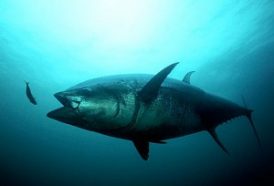Traveling tuna
Young Atlantic bluefin tuna swim the sea from coast to coast
Share this:
- Share via email (Opens in new window) Email
- Click to share on Facebook (Opens in new window) Facebook
- Click to share on X (Opens in new window) X
- Click to share on Pinterest (Opens in new window) Pinterest
- Click to share on Reddit (Opens in new window) Reddit
- Share to Google Classroom (Opens in new window) Google Classroom
- Click to print (Opens in new window) Print
By Susan Gaidos

Apparently, even fish want to break the rules sometimes.
After spending weeks and months swimming in the open sea, mature Atlantic bluefin tuna return to the area where they first hatched. They do so in order to spawn, or reproduce. These bluefin tuna are divided into two groups: western Atlantic bluefins and eastern Atlantic bluefins. When it’s time to mate, the mature westerners head toward the Gulf of Mexico. Mature easterners, in contrast, head off to the Mediterranean.
But a new study shows that when bluefins are young, they don’t always stick to their side of the ocean. Scientists found that juvenile bluefins like to socialize on both sides of the Atlantic. To these young fish, the ocean is just one gigantic aquarium.
This mingling may be good for the fish. However, it can complicate strategies that governments come up with to manage how many of the fish can be caught. Scientists say the new findings may help in setting better management strategies. And it may even save the fisheries from collapse.
Atlantic bluefin tuna are one of the most prized fish. Sushi lovers relish its savory taste. Fishermen like the high price tunas fetch at the fish market.

Over the past few decades, as the number of bluefin tuna has declined, scientists have sought ways to better manage these fish. A critical part of setting fishing quotas, or limits on how many fish can be caught, is estimating the how many are in a particular region.
Though scientists have known for some time that the western and eastern bluefin populations mix, management agencies that set fishing quotas have treated the westerners and easterners as two separate populations.
Jay Rooker works at Texas A&M University at Galveston. To get more specific information on where the tuna spend time, he set out to identify the origins of fish by examining the chemicals in their otoliths, or “ear stones.” Otoliths are found inside the ear and receive sound. As the fish grows, the otoliths also grow in layers that contain carbon and oxygen. These layers grow like tree rings throughout the fish’s life. The amounts of oxygen and carbon that are laid down can differ, depending on the water that the fish spends time in.
Nearly 200 Atlantic bluefins, from both sides of the ocean, were tracked over a six-year period. By examining the material in their otoliths, Rooker and his team were able to track the tunas’ travels.
More than 90 percent of the older, larger bluefins in the study and living in waters off Maine and Canada tend to be westerners, born in the Gulf of Mexico, the researchers found. Smaller, and younger, bluefins caught off the eastern United States, however, tended to originate in the Mediterranean.
Molly Lutcavage directs the Large Pelagics Research Center at the University of New Hampshire in Durham. She tracks bluefins off Nova Scotia, Canada, and says that patterns like these need to be considered when setting fishing quotas and developing plans to rebuild the tuna populations.
If not, Lutcavage says, “We could be missing the boat.”







